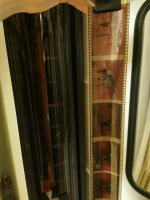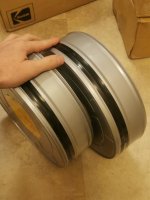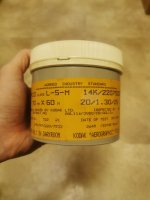Nokton48
Mentor
 Step 5 Use a dummy 220 70mm roll to set reel spacing perfectly by Nokton48, on Flickr
Step 5 Use a dummy 220 70mm roll to set reel spacing perfectly by Nokton48, on FlickrAssemble the reel, and use a 220 length of 70mm film to set the spacing between the two spirals. Do not be in a hurry, this one goes on smoothly without any issues whatsoever. Roll the complete dummy film all the way on to the reel, make sure you are well satisified how it is going
 Step 6 Practice winding full roll onto reel until you are satisfied by Nokton48, on Flickr
Step 6 Practice winding full roll onto reel until you are satisfied by Nokton48, on FlickrWhen you are well satisfied that the roll goes completely smoothly onto the reel, remove the film carefully, and then drill and install the three stainless steel screws to lock everything down on the second spiral. After final assembly, make sure to try loading the roll a few more times to make sure all is good.
The reel is now ready for use in the small Paterson tank.
Nokton48
Mentor
 8 Reel Paterson Tank coming my way by Nokton48, on Flickr
8 Reel Paterson Tank coming my way by Nokton48, on FlickrThis cracked eight reel Paterson is coming my way. If watertight I might just leave it wrapped, if it will spin properly on an olde Unicolor Uniroller. It has the lighttight column unharmed I believe. These are getting hard to find
Nokton48
Mentor
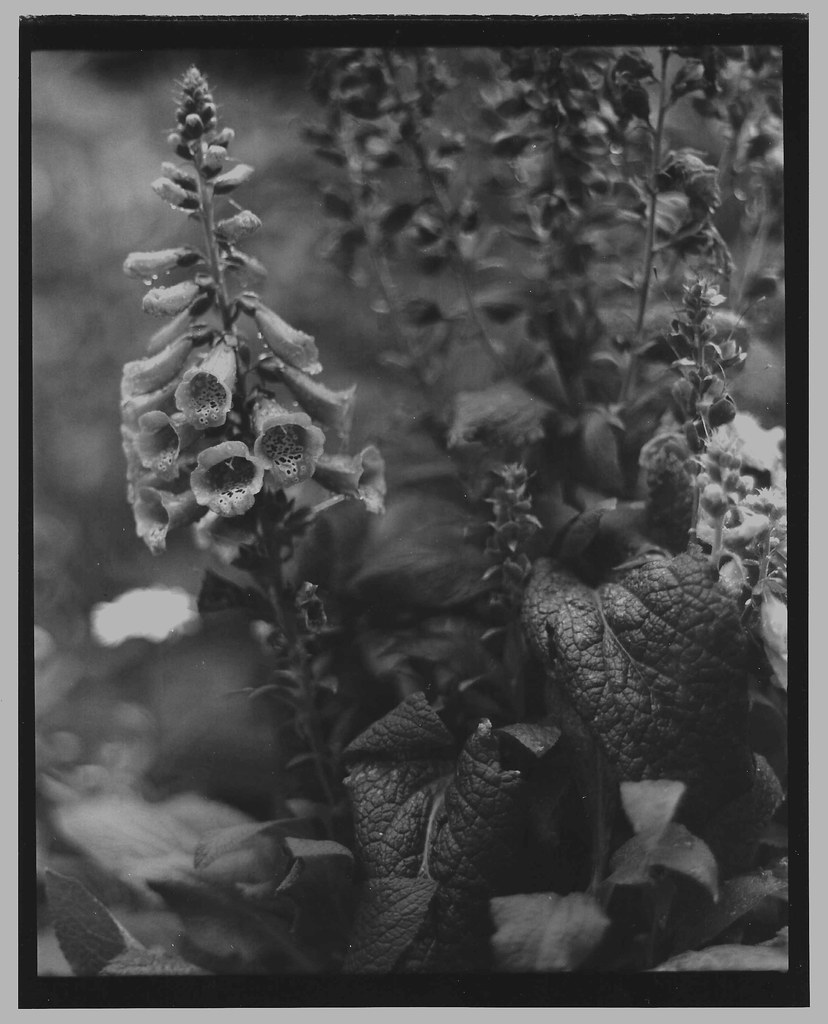 Foxglove on Rainy Back Deck by Nokton48, on Flickr
Foxglove on Rainy Back Deck by Nokton48, on FlickrFirst test roll of hand spooled 1992 vintage 70mm Kodak 400 Tri-X Professional Unperfed film. Rated at EI 400, extremely dark stormy rainy day on my back deck. Camera was Plaubel Makiflex Standard, lens is Bausch and Lomb Super Cinephor 159.1mm F2.0. A movie theatre projection lens intended for projecting 35mm and 70mm movie film in cinema houses. Film back is Graflex RH-50 24 shots bulk loaded. Film processed in D23 1:1 12 minutes at 74F in single reel Paterson dev tank. RC 8x10 print Arista [NODE="2"]Forum[/NODE] Matte developed in Multigrade. Omega DII with Omegalite laser aligned 180mm black Rodagon lens. Camera was handheld at the Makiflex Standard's top speed of 1/125. I really like the "look" I am getting with this extremely unusual lens. It's quite a heavy rig so I get a gym workout to boot. I am really diggin' all this 70mm stuff at this point. 24 6x7 exposures fits into two Vue-All 70mm pages when cut into threes. DOF virtually nil uber speed lens focused on bells on left side. Focus dead on.
Nokton48
Mentor
 Daisies in the Rain Front Yard by Nokton48, on Flickr
Daisies in the Rain Front Yard by Nokton48, on FlickrFirst test roll of hand spooled 1992 vintage 70mm Kodak 400 Tri-X Professional Unperfed film. Rated at EI 400, extremely dark stormy rainy day on my back deck. Camera was Plaubel Makiflex Standard, lens is Bausch and Lomb Super Cinephor 159.1mm F2.0. A movie theatre projection lens intended for projecting 35mm and 70mm movie film in cinema houses. Film back is Graflex RH-50 24 shots bulk loaded. Film processed in D23 1:1 12 minutes at 74F in single reel Paterson dev tank. RC 8x10 print Arista [NODE="2"]Forum[/NODE] Matte developed in Multigrade. Omega DII laser aligned 180mm black Rodagon lens. Camera was handheld at the Makiflex Standard's top speed of 1/125. I really like the "look" I am getting with this extremely unusual lens. It's quite a heavy rig so I get a gym workout to boot. I am really diggin' all this 70mm stuff at this point. 24 6x7 exposures fits into two Vue-All 70mm pages when cut into threes.
Nokton48
Mentor
 Increasing Film Speed Petersons 2485 by Nokton48, on Flickr
Increasing Film Speed Petersons 2485 by Nokton48, on Flickr SONY DSC by Nokton48, on Flickr
SONY DSC by Nokton48, on FlickrWell I tried a 70mm roll of 24 and actually got some images. The deep deep brownish dichroic fog is enough to ruin the results. Really extreme. So I need to use an ACID STOP BATH, I used running water as usual. Also in his article Bill Pierce did say "Use only fresh Acufine". And I have a gallon that is a couple of years old. So I am buying a fresh quart from B&H and I'll have a go with that in my modified one reel Paterson tank. Inversion agitiation not using Uniroller for a bit. But I did pick up a couple of eight reel Paterson tanks new, and twenty four extra reels. I work on all of this when I have time.
See the highlighted section. Was not aware I needed to use acid stop bath. Will try again when I get everything together
Nokton48
Mentor
 5 Inch 2402 Aero PX ADOX Borax 240 Tele Xenar by Nokton48, on Flickr
5 Inch 2402 Aero PX ADOX Borax 240 Tele Xenar by Nokton48, on FlickrTesting the bigger brother (to 70mm which I also have) 5 Inch Wide Kodak Aero Plus-X 2402 Perfed cut down to 4x5
5 inch Kodak Aero 2402 Plus-X cut down to 4x5. Plaubel Makiflex, Linhof Glass Plate Holder, ADOX Borax MQ developer just mixed up, 8x10 Arista [NODE="2"]Forum[/NODE] RC print. Omega DII laser aligned with 180mm black Rodagon, Multigrade developer. This 2x3 240mm Tele-Xenar I have not used much at all. F5.6 or F8 so not much DOF in this closeup. Next I will try D23 1:1 as I know that works well with 2402
Got some luscious 2402 70mm negs D23 1:1 which I need to print. One is in one of the enlargers right now
Nokton48
Mentor
 6x7cm 70mm Kodak 2402 Aero Film Perfed 1982 dated by Nokton48, on Flickr
6x7cm 70mm Kodak 2402 Aero Film Perfed 1982 dated by Nokton48, on FlickrThis is the Makiflex Automatic with 240mm chrome barrel Schneider Tele-Xenar, a 2x3 lens that I have not used much. Graflex RH-50 70mm back 6x7cm/18 exp. Kodak Aerographic Plus-X 2402 type II perfed, developed in Paterson five reel tank with custom twin 70mm reels. D23 1:1 12 minutes at 73F produces a beefy negative easy to print. 8x10 Arista [NODE="2"]Forum[/NODE] RC developed in Multigrade. Omega DII laser aligned 180mm black Rodagon, I like using the Makiflexes in the studio with my olde Broncolor strobes. Classic Kelly lighting. Depth of ifeld is extremely limited in this setup, but the central buds of the flowers are sharp near the center of the print. This olde film has a softness that I like. Looks vintage and now retro
This film came to me recently in four 40 foot rolls. Dated 1982 took a chance on condition. Seems to be fine.
Kai-san
Filmwaster
I shot a lot of 70mm film on vacation this year with Hasselblad and Mamiya RB67 backs. Some problems with both backs, I had to give up the Hasselblad eventually. Here is a couple of woodland shots, both shot at aperture 2.8.
Hasselblad 501CM / Zeiss Planar 2.8/80 / Rollei Professional 400 @ 100 ISO in Rodinal
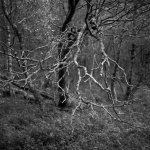
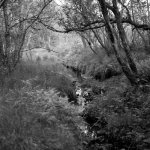
Hasselblad 501CM / Zeiss Planar 2.8/80 / Rollei Professional 400 @ 100 ISO in Rodinal


Nokton48
Mentor
I shot a lot of 70mm film on vacation this year with Hasselblad and Mamiya RB67 backs. Some problems with both backs, I had to give up the Hasselblad eventually. Here is a couple of woodland shots, both shot at aperture 2.8.
Hasselblad 501CM / Zeiss Planar 2.8/80 / Rollei Professional 400 @ 100 ISO in Rodinal
Hi Kai,
These have a beautiful tonality. Sorry about problems, I trade stuff out until I get it repaired easily. Two of my six A70 Hassy Backs need adjustment. Not something every repair shop will touch.
 SONY DSC by Nokton48, on Flickr
SONY DSC by Nokton48, on Flickr24cmx74m Agfa Aviphot. This is the plastic can inside the outer box. I cut off some leader which had some tape residue on it. So these were run through my Rototrim Cutter, a piece of Kodak MINR cutdown to 18x24 used for sizing the sheet, with blue masking tape. Pretty easy to do this in the dark, I have eight of these olde wooden Norma Holders I like them. I could also make 8x10 sheets with two cuts, and it'll make scrap. But it's 8x10! Personally I like 18x24 negs centered on a 8x10 fibre paper. Makes a beautiful border and I show the whole negative.
This is the same emulsion we have discussed extensively here, just giganto in scale.
z.bruce.li
Established
Hi, I got an older A70 back with two cassettes in it. One of them (takeup side) seems to have film in it. The ISO dial says 400 on the back. So here is my questions:
1) Do you know any 70mm double perforated film emulsions that is ISO 400? There is some marking on the cassette says "CR", which might or might not mean "Color Reversal"
2) I intend to develop 6 frame length of this mystery film, to see if there is any images or if the roll is unexposed. After some research, I plan to use B&W chemistry so I don't ruin the images entirely. I heard that if the original film is B&W, bleach process in E6/C41 might erase usable images.
Thank you in advance.
1) Do you know any 70mm double perforated film emulsions that is ISO 400? There is some marking on the cassette says "CR", which might or might not mean "Color Reversal"
2) I intend to develop 6 frame length of this mystery film, to see if there is any images or if the roll is unexposed. After some research, I plan to use B&W chemistry so I don't ruin the images entirely. I heard that if the original film is B&W, bleach process in E6/C41 might erase usable images.
Thank you in advance.
Pixel2
Newbie
Hi guys, long time lurker and 70mm shooter here.
Great to see this thread still going.
I'm processing my film using jobo expert tanks and my kindermann tank is just sitting gathering dust so decided to let it go, drop me a message if interested.
And here is a photo of my just dried 70mm film.
It's Fuji CDU2 Cross processed in C41.
Fuji CDU2 is Tungsten balanced slow and low contrast slide, it works really well shot in daylight without any filters and then cross processed.
When shot filtered and processed in e6 it has lovely pastel colours.
Great to see this thread still going.
I'm processing my film using jobo expert tanks and my kindermann tank is just sitting gathering dust so decided to let it go, drop me a message if interested.
And here is a photo of my just dried 70mm film.
It's Fuji CDU2 Cross processed in C41.
Fuji CDU2 is Tungsten balanced slow and low contrast slide, it works really well shot in daylight without any filters and then cross processed.
When shot filtered and processed in e6 it has lovely pastel colours.
Attachments
Pixel2
Newbie
Those are spectacular!
Pixel2
Newbie
24cmx74m Agfa Aviphot. This is the plastic can inside the outer box. I cut off some leader which had some tape residue on it. So these were run through my Rototrim Cutter, a piece of Kodak MINR cutdown to 18x24 used for sizing the sheet, with blue masking tape. Pretty easy to do this in the dark, I have eight of these olde wooden Norma Holders I like them. I could also make 8x10 sheets with two cuts, and it'll make scrap. But it's 8x10! Personally I like 18x24 negs centered on a 8x10 fibre paper. Makes a beautiful border and I show the whole negative.
This is the same emulsion we have discussed extensively here, just giganto in scale.
Have you managed to test it yet? I was considering buying it myself but was hesitant knowing how warm it gets there.
Nokton48
Mentor
Hi, I got an older A70 back with two cassettes in it. One of them (takeup side) seems to have film in it. The ISO dial says 400 on the back. So here is my questions:
1) Do you know any 70mm double perforated film emulsions that is ISO 400? There is some marking on the cassette says "CR", which might or might not mean "Color Reversal"
2) I intend to develop 6 frame length of this mystery film, to see if there is any images or if the roll is unexposed. After some research, I plan to use B&W chemistry so I don't ruin the images entirely. I heard that if the original film is B&W, bleach process in E6/C41 might erase usable images.
Thank you in advance.
I believe Kodak made Portra 400 in 70mm for the school camera guys? There is a lot of 70mm C41 films out there....... I bought a 100 foot roll of Portra 100, I use it to make dummy rolls for film back spacing-testing. Gotta have those dummy rolls
If what you have is E6 70mm film, of course you can cross process it for cool color tones.
Pixel2
Newbie
Pixel2
Newbie
z.bruce.li
Established
I believe Kodak made Portra 400 in 70mm for the school camera guys? There is a lot of 70mm C41 films out there....... I bought a 100 foot roll of Portra 100, I use it to make dummy rolls for film back spacing-testing. Gotta have those dummy rollsSharpie pens for marking those dummies.
If what you have is E6 70mm film, of course you can cross process it for cool color tones.
Thanks for the answer. I also got some good info from flickr cross-processing group and photrio/APUG darkroom group. I will start with Rodinal 1+50 stand development for 15 min at 20C. If there is any image at all, and either bleach it (if the film were E6) or use it as is (if the film were B&W).
I also got myself two older Ansco daylight tanks, which accepts 616/116 film that happen to be 70mm as well. Ready for some experiments this weekend!
Nokton48
Mentor
If anything interesting develops LOL why not post it here. Those HP5+ underwater in turbid water certainly are beautiful. I used to shoot superslide format in my underwater Hasselblad in Ikellite Housing with Honeywell 700 Strobonar also in Ikelite underwater housing. Did a lot of diving on Andros Island in the Bahamas. Seeing those photos makes me miss scuba diving.
z.bruce.li
Established
I have another question: when you load the bulk film into cassette in the dark, how do you measure the length of the film? For example: 24 exposures (about 64" including leaders I guess, like 220). Do you have any DIY device to keep track of the length of film loaded?
I find it easiest to load the spool until the film is just under the flange edges, shoot 24 exp, snip that off, and then, attach the film to another take up spool and keep shooting from that same supply cassette. Given film feeds cassette to cassette you can do this easily enough even in subdued daylight. With the Agfa I've mostly been using, the film base is so thin a full spool would actually hold closer to 100 frames, than 70. Enough to get around 75 frames of usable film in 24 exp lots.I have another question: when you load the bulk film into cassette in the dark, how do you measure the length of the film? For example: 24 exposures (about 64" including leaders I guess, like 220). Do you have any DIY device to keep track of the length of film loaded?
I shot 24 frames of Plus-X earlier this week, which I'll hopefully develop tonight.
Share:
-
This site uses cookies to help personalise content, tailor your experience and to keep you logged in if you register.
By continuing to use this site, you are consenting to our use of cookies.


